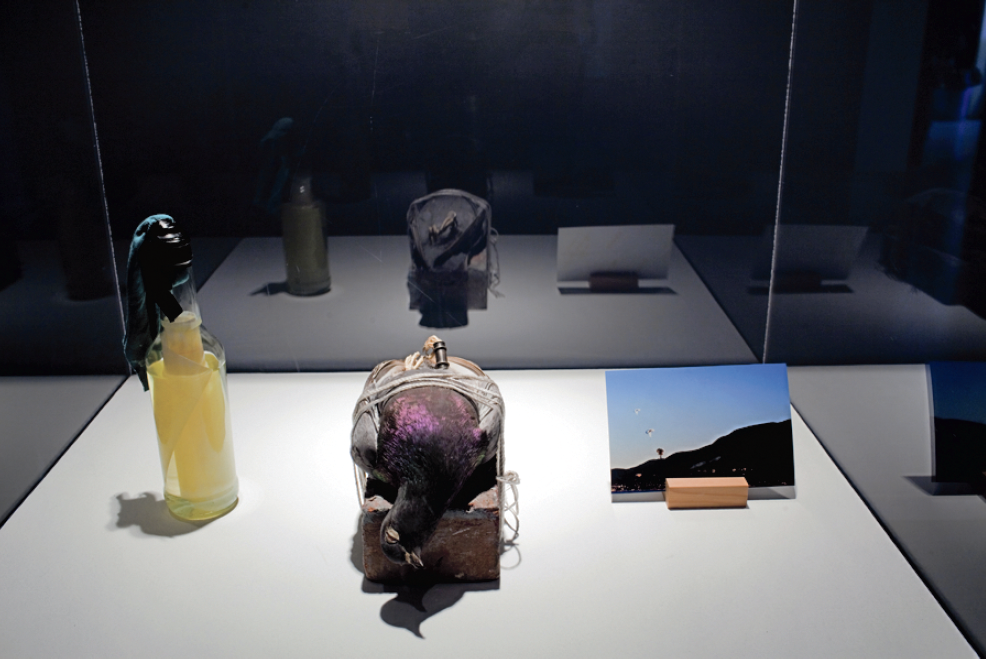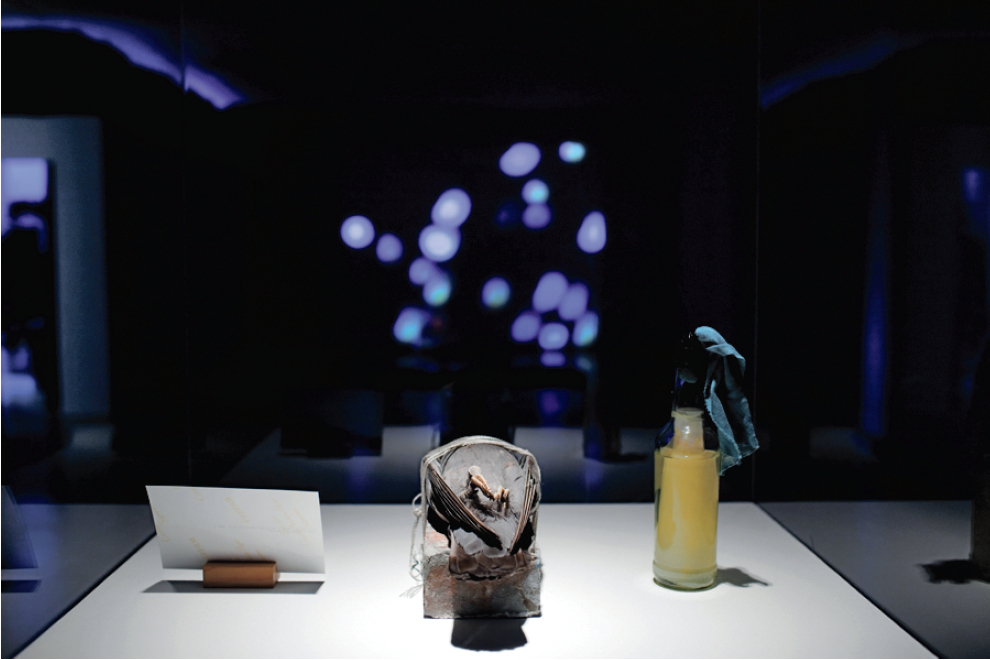Abbas Akhavan
It is difficult to isolate the specific source of tension common in Abbas Akhavan’s art. Whether it is the apt pairing of seeming oppositions recurrent in his work or the anxiety that is often mined, in “Correspondences” it is the implied violence that is the most apparent source. This latent sense of violence, which serves as a connective thread for the two works in his recent exhibition—a video projection and a sculptural triptych—is reinforced by the percussive explosions echoing on a loop throughout Modern Fuel’s main gallery.
After a series of residencies in Europe, the Toronto-based Akhavan returns to Canada for a gruelling schedule of exhibitions that began with the presentation of his work in Kingston. Born in Tehran and a graduate of the University of British Columbia’s MFA program, Akhavan is establishing a strong reputation nationally and inter- nationally through almost constant artistic activity.

Abbas Akhavan, Correspondences, 2006, bottle, gasoline, oil, handwritten letter, cloth, electrical tape, taxidermied pigeon, brick, string, letter carrier and letter; digitally altered photograph. Dimensions variable. Photographs: Chris Miner. Images courtesy the artist and Modern Fuel Artist-Run Centre, Kingston.
The titular sculptural triptych that opens the show was created during a residency at Stratagem Pacific Consulting, a conflict resolution firm headquartered in Vancouver. Each object is a hybrid of missive and missile, registering as both a mode of communication and a tool of violence and destruction. The trio constituting “Correspondences” includes a propped-up image that could serve as a postcard depicting a mountainous horizon line with a dissipating mushroom cloud against a serenely clear blue sky. At the centre is a prone pigeon with iridescent breast plumage turned skyward, identified as a carrier or homing pigeon by the aluminum capsule attached to its right leg. Eyes half-closed, the dead bird is rendered an ominous projectile by a white string binding it to a weathered red brick. The third object is a letter in a bottle designed to double as a Molotov cocktail. The forlorn attempt at communi- cation is combined with the guerrilla explosives of the socially and politically dispossessed. Ripe with contradictions, each element seemingly neutralizes itself. Atop a plinth and beneath a museum case with focused spot-lighting, the piece is one part of an impeccable installation, curated by Michael Davidge, that elevates a space that can at times be dingy.
Projected from floor to ceiling against the north wall of the gallery, the looped video titled August 2006 begins with a downward focus on asphalt. The entire space is darkened save for the lighting of the case. The din of the crowds in the street is punctuated by the background noise of successive explosions. As the handheld camera pans up and begins to move through the crowded streets the silhouette of the operator is outlined by intermittent flashes of light. Shaking in concert with the explosions and the increasing pace of the camera, a mother pushing a stroller races past the now eye-level view. The frantic perspective of the projection recalls amateur eyewitness footage of conflict or catastrophe familiarized by the 24-hour news cycle, an association reinforced by the 10-year anniversary of 9/11 in the month previous to the show. The light flashes accompanying the sounds of explosion delineate the city buildings, further creating the impression of violence on a grand scale. With the flagging of the camera’s pace the initial sensation of panic and potential trauma are undermined by the distinguishable conversations of bystanders and a group of calm police officers. Joining a crowd of people, the focus again turns skyward and fireworks can now be distinguished through the crowded city skyline. As the sustained focus on the fireworks becomes more intense and singular, surrounding sounds die down. The explosions of coloured light effectively become abstract paintings in the darkened gallery.

Abbas Akhavan, “Correspondences” (foreground); video still from August 2006, 2006, digital video, 7 minutes, 43 seconds (background).
Filmed during Vancouver’s annual “Celebration of Light,” the piece is an uncanny immersion in the geographic and temporal fold Akhavan experienced upon waking to the sound of fireworks and recalling, for him, the trauma of being a war refugee. Vancouver serves as an apt setting for a consideration of collective violence, and a common conceit of other art focused on the city. A reoccurring trope in Akhavan’s work, fireworks also highlight the relationship between celebration and destruction, an excessive decadence with roots in warfare. This is one of the many dichotomies he examines in his larger body of work, particularly an emerging interest in the domestic as a fertile space for both hospitality and hostility. The lasting after-image of the fireworks, which is startlingly pretty, also allows an effective release of the tension created through the misapprehension and possibility of miscommunication at the heart of both works, serving as summation to a potent exhibition. ❚
“Correspondences” was exhibited at Modern Fuel Artist-Run Centre, Kingston, from October 1 to October 29, 2011.
Matthew Hills is an independent curator and culture worker based in Kingston.

